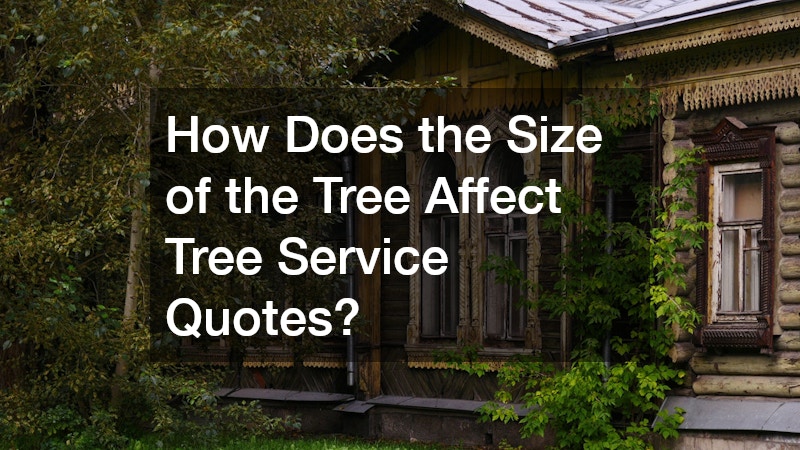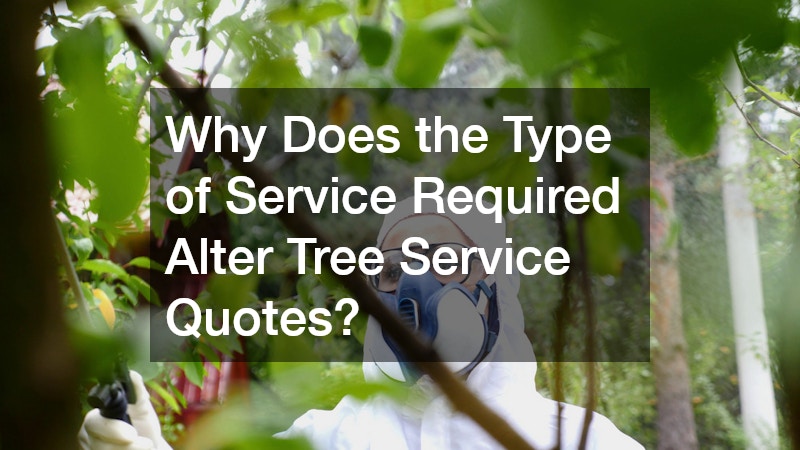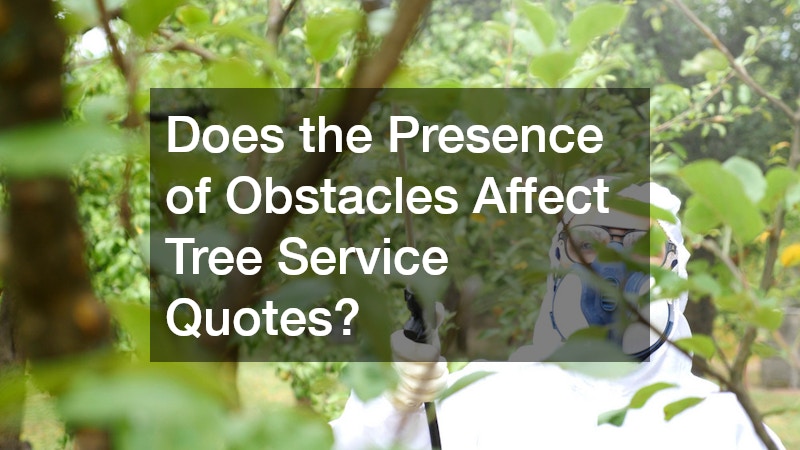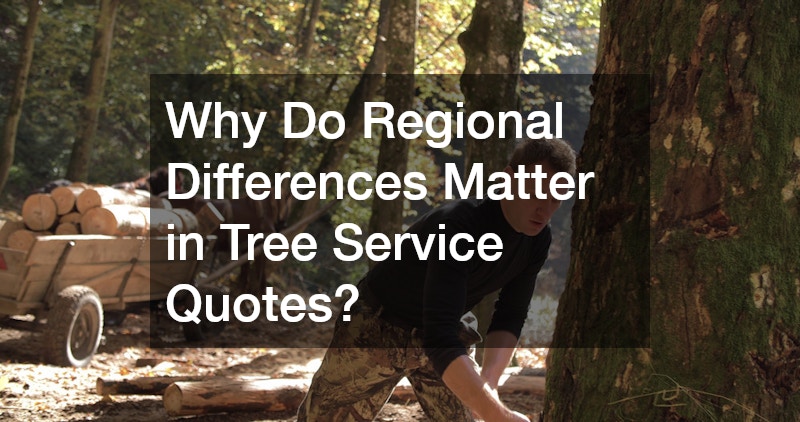This article delves into the critical factors that influence tree service quotes for both residential and commercial purposes. While many property owners may assume that cost is determined solely by the size of a tree or the scope of work, the reality is far more complex. Factors such as tree health, accessibility, specialized equipment requirements, and even seasonal demand all play significant roles in shaping the final price. Understanding these elements not only helps property owners make informed financial decisions but also ensures they receive services that balance affordability with safety and quality. By examining these ten factors in detail, property owners can gain valuable insights into what affects pricing in the tree service industry, empowering them to confidently compare quotes and choose the best option for their unique needs.
1. How Does the Size of the Tree Affect Tree Service Quotes?

The size of the tree is arguably the most impactful factor when determining tree service quotes. Larger trees generally require more manpower, equipment, and time, all of which increase the cost of the service. Local tree services may need special permits or equipment to deal with exceptionally large trees, adding to the complexity and cost.
For example, a large oak tree would necessitate more resources than a smaller shrub, thereby increasing labor and equipment expenses. Tree removal of a giant tree often demands the use of cranes or other heavy-duty machinery, amplifying the overall costs involved. Consequently, tree service quotes are adjusted upward for larger trees to accommodate the extra work and resources.
In contrast, smaller trees or shrubs might require only basic tools and less manpower, thus resulting in lower tree service quotes. However, it is essential to remember that even small trees can sometimes pose challenges based on their location or condition. The key takeaway is that tree size is a major component and often the starting point in estimating overall service costs.
2. What Role Does Tree Health Play in Determining Tree Service Quotes?
The health of a tree is another crucial consideration affecting tree service quotes. Damaged or unhealthy trees can become hazardous, requiring specialized techniques for removal or treatment. For a tree trimming service, unhealthy trees may require additional care to ensure that the trimming does not further compromise the tree’s integrity.
Sick or decaying trees might also increase risks for workers, necessitating higher insurance coverage and risk premiums, which naturally reflects in the quotes. Moreover, diseases can spread from the primary tree to others, making immediate intervention by local tree services crucial to halt their advance. As a result, servicing unhealthy trees often involves added complexity, pushing up the costs associated with the care.
Conversely, healthy trees in need of regular maintenance generally involve standard procedures like periodic trimming or fertilization. These routine tasks are quicker and safer, producing more steady and predictable tree service quotes. Maintaining tree health through regular checks can actually reduce long-term costs by preventing the expensive treatments necessary for severely affected trees.
3. How Do Location and Accessibility Impact Tree Service Quotes?
The location and accessibility of a tree can significantly impact tree service quotes. Trees situated near structures like houses or restaurants may require additional precautions and techniques for removal or trimming to prevent damage, increasing the labor costs. Accessibility issues, such as confined spaces or difficult terrain, may also necessitate special equipment like cranes or lifted platforms.
If a tree is located in a congested urban area, crews might need permits or traffic control measures, both of which could elevate quotes provided by local tree services. Conversely, trees situated in open landscapes can often be accessed and serviced more easily, potentially lowering costs. The proximity of a tree to service centers also matters, as distant locations may incur additional travel charges.
Unique situations, like trees grown over swimming pools or near lawn irrigation systems, add layers of complexity to the job. The effort to mitigate potential issues during tree removal or trimming in such scenarios often leads to higher tree service quotes. Thus, the location and accessibility play a critical role in determining the extent of the resources and techniques required.
4. Why Does the Type of Service Required Alter Tree Service Quotes?

The type of service requested is a fundamental element affecting tree service quotes. Tree removal generally commands higher quotes due to the inherent risks and equipment needed, compared to simpler tasks like a tree trimming service. Additionally, specialized services such as disease treatment, fertilization, or emergency storm response escalate costs due to their urgent or technical nature.
A commercial landscaper might require periodic maintenance services, like trimming and lawn care, which involves different pricing than one-time emergency services. Shaping or aesthetic trimming for visual appeal also differs in cost due to the additional time and expertise required. Consequently, understanding the specific service needs can help set realistic expectations for the quotes received.
Moreover, services related to sustainability, like replanting or environmental restoration, require distinct approaches and resources. These tasks focus on long-term results, which can elevate initial costs to get started. However, such investments can lead to cost savings over time by reducing tree-related issues and enhancing landscape health.
5. How Seasonal Demand Influences Tree Service Quotes?
Seasonal demand significantly influences tree service quotes, often dictating the availability and price of services at different times of the year. During peak seasons, such as early spring or late fall, high demand can lead service providers to increase their rates. This period aligns with critical activities like trimming and removal when property owners prepare their landscapes for season transitions.
Off-peak seasons may offer reduced rates as local tree services seek to balance out their workload and optimize resource utilization. In some cases, this can lead to lower quotes as companies offer discounts to maintain consistent business year-round. Understanding these seasonal trends can help property owners strategically plan their tree service needs to take advantage of potential savings.
Moreover, emergency services necessitated by seasonal storms can lead to increased demand and higher costs due to urgency. During these times, the availability of resources becomes strained as many seek immediate assistance for damaged trees. Hence, planning routine services outside these peak periods can provide more flexibility and potentially better rates.
6. How Does the Equipment Needed Affect Tree Service Quotes?
The equipment required for tree services is a significant determinant of tree service quotes. Complex tasks often necessitate sophisticated machinery, including cranes, chippers, or elevated platforms, driving up costs. Each piece of specialized equipment incurs additional operational and maintenance expenses for service providers, which are reflected in customer quotes.
For example, the tree removal of large or challenging specimens might necessitate cranes for safety, adding considerable overhead to the service cost. Routine tasks like tree trimming may only require basic tools like chainsaws and pruning shears, usually leading to lower expenses. However, the unique demands of each job ultimately dictate the type of equipment needed for efficient service delivery.
Furthermore, advancements in equipment can enable more precise and faster services but may also increase initial costs due to higher technology expenses. As service providers aim to stay competitive, continual investments in the latest equipment may be necessary, eventually impacting their pricing strategies. Thus, the type and amount of equipment significantly shape the final tree service quotes given to customers.
7. Does the Presence of Obstacles Affect Tree Service Quotes?

The presence of physical obstacles is a key factor that impacts tree service quotes, as these hurdles can complicate the labor involved. Factors such as fences, power lines, or closely placed structures often necessitate specialized techniques or coordination, increasing the complexity of the task. These challenges require careful evaluation, planning, and often additional manpower.
For instance, performing tree trimming or removal near utility lines may involve additional safety measures and coordination with utility companies. Such coordination can extend the timeline and increase service costs significantly. Similarly, working within proximity to commercial properties like restaurants poses additional liability risks that drive up project quotes.
Physical obstacles require extra time and effort from service providers, raising the overall cost. As a result, understanding the environment surrounding a tree is crucial for accurately estimating the resources and time required for the service. Costs will typically be adjusted to compensate for these added challenges, as they pose higher risks and require greater care.
8. What is the Impact of Project Complexity on Tree Service Quotes?
The complexity of a tree service project is directly tied to the tree service quotes due to the varying levels of expertise and resources required. Complex projects often involve multiple facets, such as interfacing with lawn care service elements or tackling intricate tree removal tasks. Each project’s unique characteristics dictate the required skills, manpower, and time allocation.
For projects combining lawn irrigation optimization with tree trimming or removal, the intricate balance between maintaining landscaping features and ensuring tree health adds to the complexity. This requires tailored approaches that inevitably lead to higher costs. Therefore, assessing the complete scope of the project is essential to accurately forecast quotes.
Simultaneously, specialized projects that aim for aesthetic enhancements through specific trimming techniques or integration with landscape designs demand nuanced approaches. These nuanced projects often involve collaboration with commercial landscapers and can result in elevated pricing due to specialized skill sets required. Understanding the complexity upfront enables more precise project planning and cost projections.
9. How Do Company Certifications and Experience Influence Tree Service Quotes?
The certifications and experience level of a tree service provider play a significant role in shaping tree service quotes. Companies with industry-recognized certifications ensure adherence to safety and quality standards, which may result in higher service rates. Their qualifications often lead to more reliable assessments and effective problem-solving, providing long-term value to clients.
Experienced providers bring seasoned expertise to complex jobs, offering efficient solutions that new companies may struggle to handle. This efficiency and assurance frequently come with a premium reflected in the quotes. However, investing in experienced services supports superior outcomes that can mitigate risks and future costs.
On the other hand, companies that operate without proper certifications may offer lower initial quotes, but the potential risks include subpar work or non-compliance with local regulations. These risks underscore the importance of verifying certifications and experience levels when evaluating tree service quotes. Hence, assessing these credentials helps property owners balance costs against the necessity for skilled service.
10. Why Do Regional Differences Matter in Tree Service Quotes?

Regional differences are a vital consideration when evaluating tree service quotes, as they influence availability and pricing of services. Labor costs, local regulations, and the prevalence of certain tree species directly affect the quotes across various regions. In areas where certain trees are prone to specific diseases, service providers may adjust their quotes to reflect necessary preventive measures.
For instance, areas with high property taxes or stringent permitting processes may incur higher operational costs for providers, resulting in elevated quotes. These regional economic disparities contribute to the variability in pricing across different geographic locales. Understanding these regional factors can help property owners anticipate the related impacts on their service quotes.
Furthermore, regional climates affect seasonal operations and demand. In regions where tree growth is rapid due to favorable climates, frequent maintenance may be necessary, influencing the frequency and type of required services. Therefore, recognizing how regional nuances mold pricing strategies can enable more informed decision-making when sourcing tree services.
By considering these ten key factors, property owners can gain a clearer understanding of the variables that impact tree service quotes and move beyond simply comparing prices. This awareness enables them to budget wisely, set realistic expectations, and avoid unnecessary expenses while ensuring both residential and commercial tree service needs are met with efficiency and quality. With this knowledge, property owners can confidently engage with service providers, ask the right questions, and build lasting partnerships that promote fair pricing and reliable care. Ultimately, making informed decisions not only helps optimize landscape management but also preserves tree health, enhances safety, and creates outdoor environments that remain attractive and sustainable for years to come. Taking the time to evaluate these factors carefully, from choosing the right fertilizer to selecting proper pruning methods, can make the difference between a short-term fix and a long-term investment in the health and beauty of a property.

